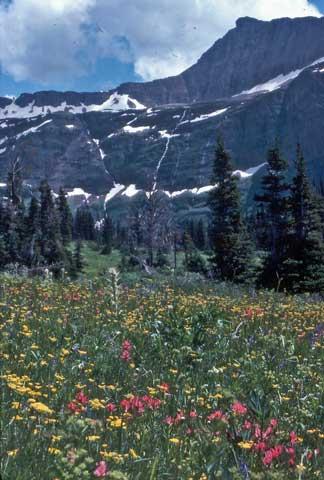Glacier National Park includes just over a million acres of superlative Rocky Mountain terrain, and the park offers an interesting combination of front-country access and backcountry solitude in what has been called "the core of the Crown of the Continent ecosystem." Glacier will celebrate its centennial on May 11, 2010, and some supporters are saying it's time to finally formalize wilderness designation for key portions of the park.
Wilderness status for parts of the area is not a new idea. The park's General Management Plan notes:
Glacier National Park completed a study and environmental impact statement in 1973 to comply with the 1964 Wilderness Act. That document, which was subject to public review, resulted in the recommendation that over 90 percent of the park should be designated as wilderness. President Nixon forwarded that recommendation to Congress on June 13, 1974. A bill was subsequently introduced to formally designate the land as wilderness. That bill was never enacted, but since that time it has been reaffirmed by every president. Amendments to the wilderness recommendation of 1974 were made in 1984 and 1994 that made minor adjustments to the original proposal…
A 1988 bill encompassing wilderness for several areas in Montana passed the Congress but was vetoed by Ronald Reagan. Another attempt in 1999 during the Clinton era failed to win congressional approval.
Trivia buffs may note the eleven year interval between the past two attempts and wonder if another try on that timetable will finally deliver a wilderness bill in time for Glacier's big anniversary in 2010. A recent news article in the Montana newspaper the Missoulian notes that while a bill is not currently in the pipeline, interest is still alive.
The key, of course, will be political support from the Montana delegation. In his 1997 work, Preserving Nature in the National Parks, Richard Sellers notes,
In part because of the opposition of local congressional members and a changing national political climate, several large parks containing huge tracts of de facto wilderness never gained the added protection of the Wilderness Act, among them Yellowstone, Grand Canyon, and Big Bend, in addition to Great Smoky Mountains.
What does the current crop of politicians think? The Missoulian quotes Senator Max Baucus, who avoided any commitments this early in the game: "I want to hear from all Montanans—especially those near Glacier—and keep every option on the table when it comes to protecting everything that makes Glacier special.”
Park publications refer to 963,155 acres in the park as defacto wilderness, and invite visitors to "Come and experience Glacier's pristine forests, alpine meadows, rugged mountains, and spectacular lakes. With over 700 miles of trails, Glacier is a hiker's paradise for adventurous visitors seeking wilderness and solitude."
If so much of the park is already being managed as defacto wilderness, why is legislative action needed at all? A NPS website on the agency's wilderness program provides a succinct answer:
The wild, undeveloped areas of national parks (often called "backcountry") are subject to development, road building, and off-road mechanized vehicular use. National park backcountry is protected only by administrative regulations that agency officials can change. The Wilderness Act protects designated wilderness areas by law "for the permanent good of the whole people." With the Wilderness Act, Congress secures "for the American people of present and future generations the benefits of an enduring resource of wilderness."
Recent history has given cause for concern about reliance solely on agency "administrative regulations" to protect defacto wilderness or other park values. As previously reported in the Traveler, proposals for major changes in NPS Management Policies in 2005 and 2006 illustrate how those guidelines can be subject to the vagaries of politics.
Although any wilderness proposal will generate a certain amount of controversy, Glacier seems to be in a better position than many other areas to eventually get a bill passed. Wilderness as proposed for this park would result in little or no change from long-established patterns of visitor use. The area also includes some resource values that are increasingly rare in the country today. The park's current General Management Plan notes
Glacier National Park exemplified the value of wilderness long before wilderness became rare....The park functions as a relatively undisturbed core of a large ecosystem that supports a tremendous variety of plants and animals. Glacier is one of the few places in the world where all the original native predators and most of their prey survive in the wild.
Previous attempts at wilderness designation for Glacier have failed largely because they were included in bills covering multiple parks, or even lands from other agencies. Perhaps careful crafting of a future bill will avoid some of those pitfalls, and this park can enter its second century with added protection for its remarkable values and resources.




Add comment